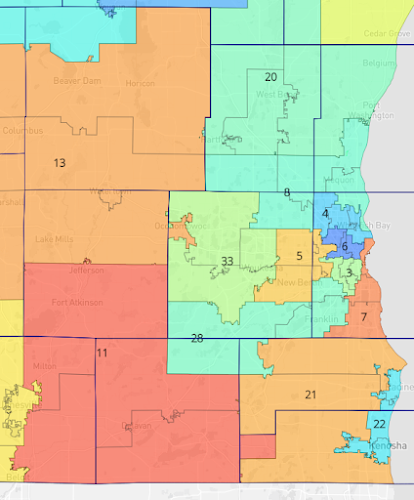Ventings from a guy with an unhealthy interest in budgets, policy, the dismal science, life in the Upper Midwest, and brilliant beverages.
Sunday, April 16, 2023
Jake does redistricting pt. 2 - the Senate maps also can get closer to reality
Following up on my post about redistricting the Wisconsin State Assembly, let's now take a look at what I did with the State Senate. Per state law, 3 Assembly districts make up one Senate district.
Now compare that to the current GOP gerrymander.
This is where the choice on where to group districts comes into play. Not only in compactness, but also in grouping communities and general competitiveness. You can see how much "tighter" district 30 in Green Bay, district 19 in Appleton/Neenah/Menasha, and district 27 west/north of Madison is on my map.
Go into the Milwaukee area, and there are noticeable differences. The current gerrymander shoves the recently-filled District 8 around 3 counties in a very odd shape, has the majority of District 5 voters be in more-GOP Waukesha County, and separates Districts 21 and 22 into a "rural vs urban" dynamic.
By comparison, my map actually helps the newly-elected Dan Knodl by making District 8 be entirely in Ozaukee and Washington Counties, but makes up for that by putting most District 5 voters in Milwaukee County, and concentrates Districts 21 and 22 into one main county, setting up two significant battleground districts.
Also worth noting, both maps have 2 majority-Black districts (4 and 6) and District 3 is majority-minority, with Hispanics being the largest ethnic group in that district.
The Fox Valley map also shows key differences. I move District 2 up in to Marinette, and make District 30 be entirely in Green Bay-centric Brown County. District 19 is tightened up into Appleton, and District 18 is almost entirely located in Winnebago County.
And these changes manifest themselves into more competitive results. Using the 2016-2020 composite figures, the GOP's gerrymander has fewer close districts, and you can see how they can slither into a 22-11 supermajority in a 50-50 (if not slightly Dem-leaning) state.
Using the same measure under my maps, GOPs would still be favored in 20 of 33 districts. But look at the large number of districts in the "competitive" range, and 53% is again around the tipping point for Dems to take the majority.
The Senate gets even more competitive if you use the post-Dobbs/Jan 6 result from the 2022 Governor's election. From what I can tell, Michels would have still won 19 of 33 districts, but 6 of the 33 districts were within 5 points (3 GOP and 3 Dem), and it makes the Fox Cities, Eau Claire and Racine/Kenosha areas into major deciders for the balance of power for the upper house.
Sure, we could be greedy and try to figure out Dem gerrymanders. But let's use these maps as the baseline, because as I mentioned in the Assembly redistricting post, merely having the CHANCE of a change in power might go a long way toward restoring confidence that Wisconsinites can have a Legislature that has to listen to what Wisconsinites want. And if GOPs arrogantly continue to ignore us, we now could vote to make the changes that are necessary for this state.
Let's make it so.







No comments:
Post a Comment